NORTH WALES COAST RAILWAY:NOTICE BOARD
Rheilffordd arfordir gogledd Cymru: Hysbysfwrdd
18 June 2018
Share on Twitter
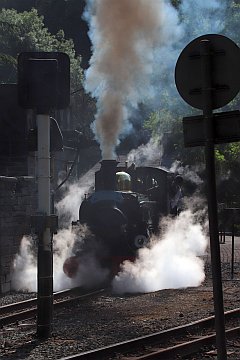
Tweets by @NWrail1
Contributions and comments are encouraged: see the Contributions Page
June 2018
30 June and 1 July Llangollen Railway Classic Transport Weekend
July 2018
7-8 July North Wales N Gauge Model Railway Show, Conwy. With 12+ layouts on show with trade support and second-hand sales. Refreshments available and full disabled access. Saturday 10:00 - 17:00, Sunday 10:00 - 16:00. Adults £4, Children £2. Ysgol Porth y Felin, Llanrwst Road, Conwy LL32 8FZ
Sunday 22 July Steam on the Coast Railway Touring Company North Wales Coast Express
Liverpool - Chester - Llandudno Junction - Holyhead and return. 45690
Tuesday 24 July Steam on the Coast Railway Touring Company Welsh Mountaineer Preston - Blaenau Ffestiniog. 45699 or 48151: Preston - Chester - Llandudno Junction - Blaenau and return
August 2018
Saturday 4 August. Steam on the Coast. Saphos Trains. Bangor (07.00/22.15) Llandudno Jct (07.25/21.55) Colwyn Bay (07.35/21.45) Rhyl (07.50/21.30) Prestatyn (08.00/21.20) Flint (08.10/21.10) Chester (08.30/20.50) Crewe (09.30/20.00) Stafford to Stratford-on Avon. 46100, 34046 or 70000.
September 2018
Saturday 8 September Steam at Chester
29 September Llangollen Railway Diesel gala
October 2018
12-14 October Llangollen Railway Autumn Steam gala
Friday 19 October Steam on the Coast Golden Eagle Luxury Tour (Day 5 of 12) (Provisional) Chester - Blaenau Ffestiniog 46100: Llandudno Junction - Blaenau Ffestiniog, Holyhead - Crewe
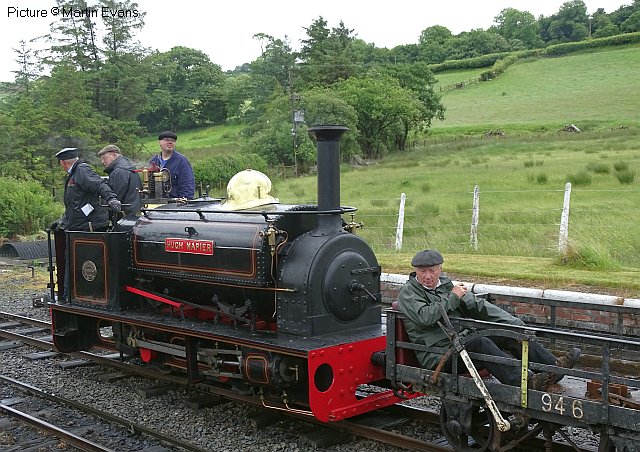
On 16 June, Hunslet 0-4-0ST Hugh Napier prepares to leave Llanuwchllyn, Bala Lake Railway, with a replica Penrhyn Railway goods train, the brakeman preparing for his journey in 'luxury'. Picture by Martin Evans: more views below.
Thanks for all the many contributions received: there will be a second update this week, hopefully by Friday evening. - Charlie
The Snowdonia Statesman - report by Gary Thomas
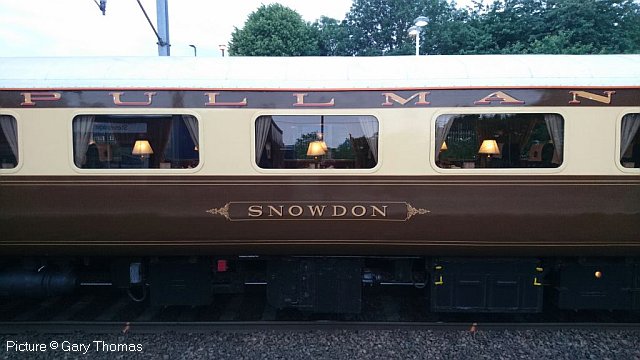
Living in St. Albans but coming from Llandudno Junction I couldn't resist a day out on the "Snowdonia Statesman" rail tour from Stevenage to Blaenau Ffestiniog on Saturday 16 June.
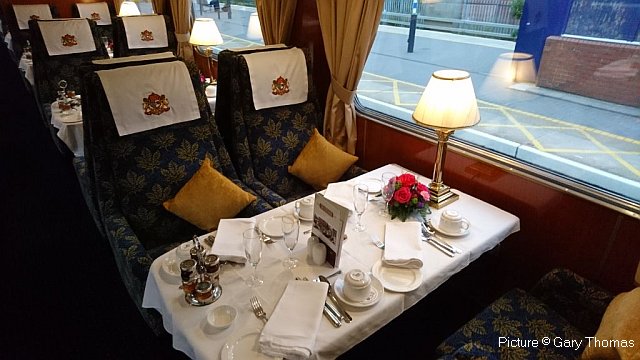
Statesman Rail has been owned since 2016 by the English businessman and Conservative donor Jeremy Hosking. Jeremy really is 'living the dream', owning a number of steam locomotives operated by his new Train Operating Company Locomotive Services Ltd, including A4 60019 Bittern. He also recently bought Deltics D9016 and 55 022 from Martin Walker. West Coast Railway Company (WCRC) were still operating this train, but I suspect this might change in the future.
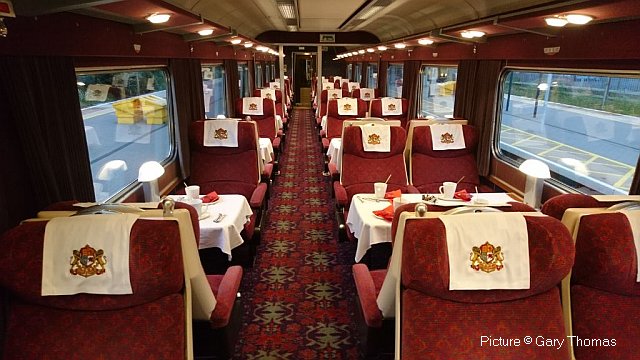
Despite being only a 20 minute drive away, I still had to get up at 4am to make the 5.44am departure from Stevenage. Parking at Stevenage station on a Saturday is £6.50, not exactly good for encouraging use public transport (unless they want people to take the bus to the railway station of course - For me I would have had to leave on Friday evening!).

Photos above: The Mark 2, air-conditioned rolling stock is in excellent condition, as evidenced by these photos of the appropriately named "Snowdon" carriage and interior shots, starting with Pullman Class Dining, then First Class non-dining and Standard Class. I was in the "cheap seats" in standard, but it was still comfortable with (of course) bays of seats aligned to windows. My ticket was a pretty reasonable £80. It really took me back to Virgin West Coast and Virgin Cross Country services in the 1990s. In my view the interiors of the Pullman carriages were as good as those in the 'Northern Belle', if not even better.
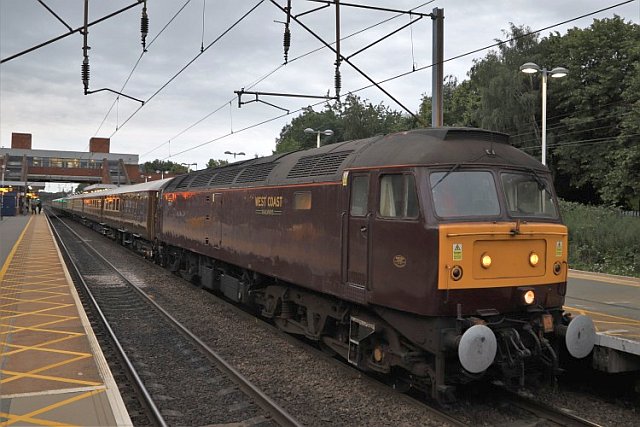
Why aren't I still in bed? WCRC class 47/4 no. 47 826 waits to leave Stevenage with the 05:44 to Blaenau Ffestiniog via Stamford, Leicester and Nuneaton.
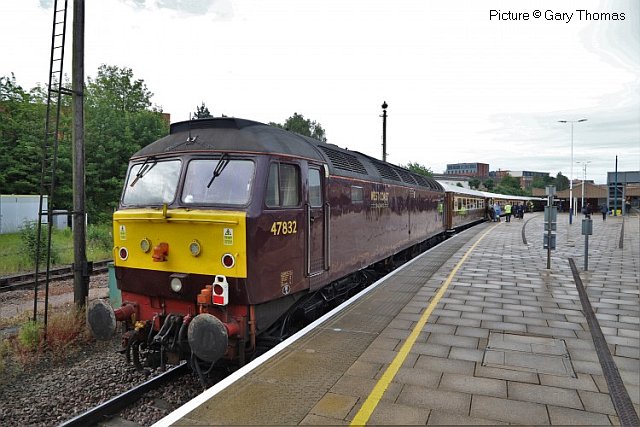
47 832 is seen at Leicester the rear of the train. My standard carriage - the only one - was immediately next to the loco.
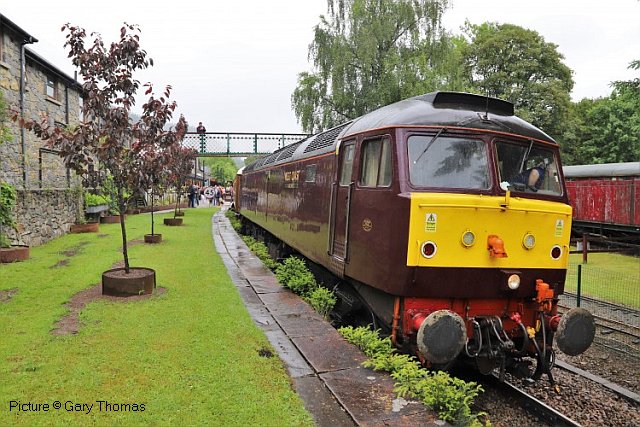
47 832, heading the train after reversal at Llandudno Junction, arrived at Betws-y-Coed 'right time', despite a late running 150/2 passing us at Llanrwst North. I would have liked to have got a photograph at 'The Junction' but the on-board stewards were not eager for people to get off, especially as we were a couple of minutes late before our reversal.
My friend and I got off at Betws-y-Coed so I could meet my father and his partner rather than brave the elements at Blaenau Ffestiniog. We then went to the Stables Bar at the exceedingly busy Royal Oak Hotel for an excellent lunch. The weather turned out pretty well considering the pessimistic weather forecast. We even had an ice cream at Cadwalders near the railway station, but as this is a few doors down, 'punters' seemed to flock to the other ice cream parlour selling the wares of Kellys of Cornwall. Buy local I, say!
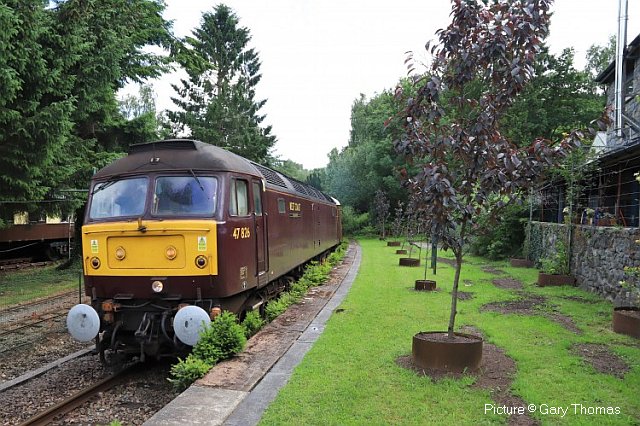
WCRC class 47/4 no. 47826 arrives at Betws-y-coed with the returning 1610 Blaenau Ffestiniog to Stevenage. I got told off for trespassing on private property, despite there not being an obvious sign. Sorry ...
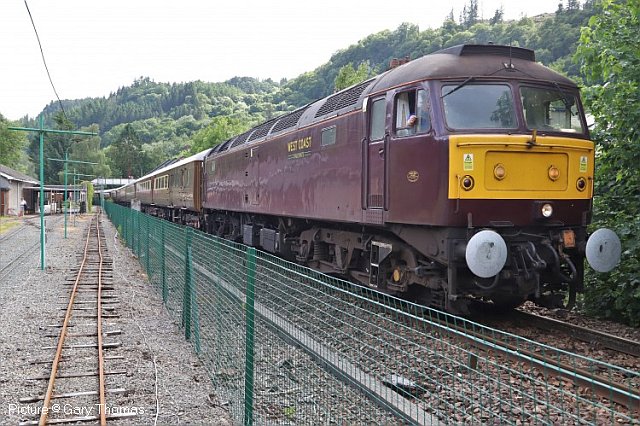
Three gauges and sadly the only electrified line in North Wales! 47 826 waits to leave Betws-y-coed.
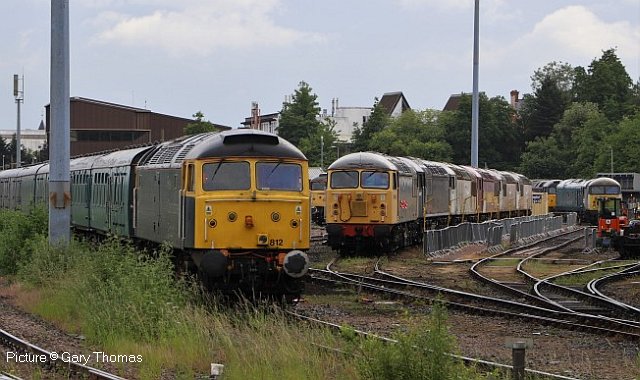
On the way back I got a good view of the 'scrap yard' that is Leicester Depot. Rail Operations Group 47 812 heads a long line of rolling stock including lots of 56s waiting for reuse with GBRf, 58 016, 50 008 and other 47s at the rather scruffy depot.
Timing was excellent for most of the day, though the timings from Crewe to to Llandudno Junction were very optimistic and on the way home we were annoyingly held near journey's end for 15 minutes at Hitchin, for only 2 people to get off when we got to the station. We could easily have cleared the platforms before the Great Northern class 700 'stopper' from Peterborough to London Kings Cross called. We arrived 2 minutes late at Stevenage (and too tired to bother taking a night shot!) after almost 18 hours on our trip. A good day was had by all, the stewards being excellent and very sociable. Needless to say, I was very happy to see my bed when I got home just after 12am.
A Selection of specials
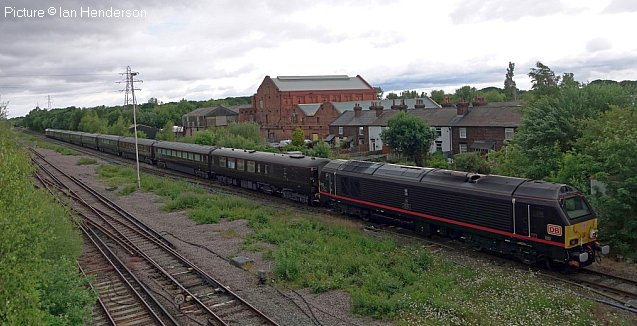
Ian Henderson was up early to find the Royal Train in the siding at Hooton, where the Royals had spent the night, on 14 June. The two Royal locos, 67 006 Royal Sovereign and 67 005 Queen's Messenger, officiated as usual. The DB sticker clashed a little with the livery, we think.

The Royal Party, including Her Majesty and the Duchess of Sussex, took the train to Runcorn station (via the Halton curve?), whence they travelled by car to visit the Catalyst science museum and officially open the new Mersey Gateway Bridge. Later they travelled by car to engagements in Chester, while (we assume) the train made its way back to base at Wolverton.
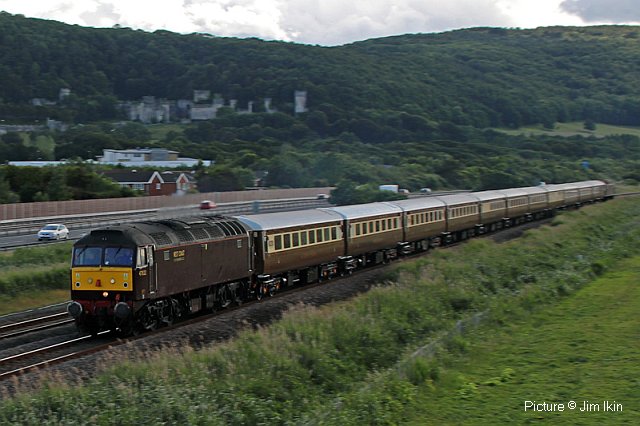
47 832 leads the return Statesman Rail excursion (see above) on 16 June past Gwrych Castle, which, it has been announced this week is now safely in the hands of the Gwrych Castle Preservation Trust after they were able to buy it thanks to a grant of £600,000 (said to be the price of a one-room flat in central London) from the National Heritage Memorial Fund and a 'major grant' from the Richard Broyd Charitable Trust (Jim Ikin). Richard Broyd is the fellow who 'made his fortune as an entrepreneur in recruitment' and then set about saving historic houses, including Bodysgallen Hall, by turning them into hotels. In 1993 he created some controversy by erecting at Bodysgallen the 64-foot hill-top obelisk which can be seen from trains near Llandudno Junction.
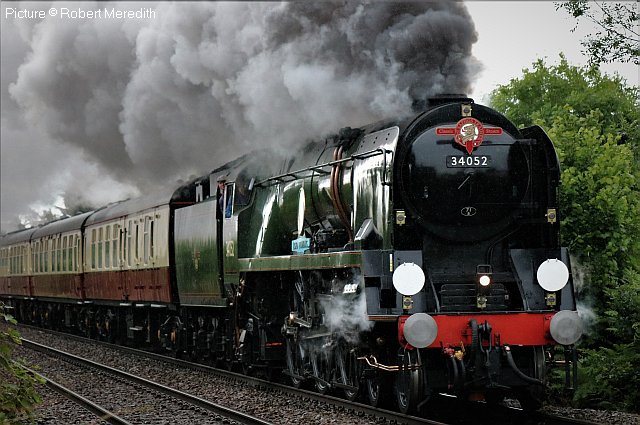
On 16 June as the recent spell of sunshine disappears and the rain returns, 34052 Lord Dowding with the Saphos Trains 'Welsh Marches' excursion from Crewe to Cardiff and return, is seen passing the former site of Willaston Station Nantwich, opened by the London and North Western Railway in 1858 and closed to passengers in December 1954 (Robert Meredith).
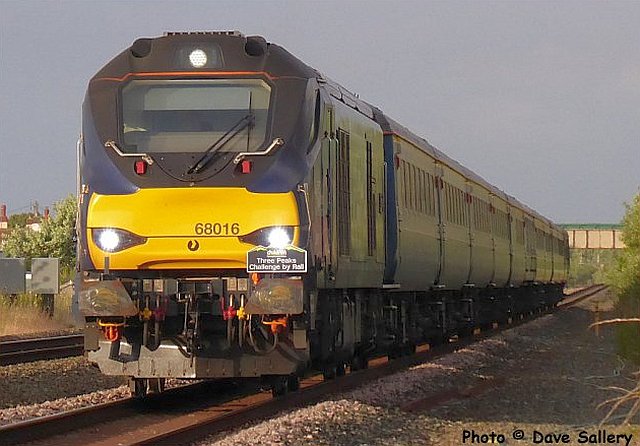
It's the time of year for the annual charity fund-raising 'Three Peaks Challenge', which as usual started with a train from Crewe to Bangor on 14 June, with DRS traction in the shape of 68 016 Fearless, seen near Rhyl (Dave Sallery)...
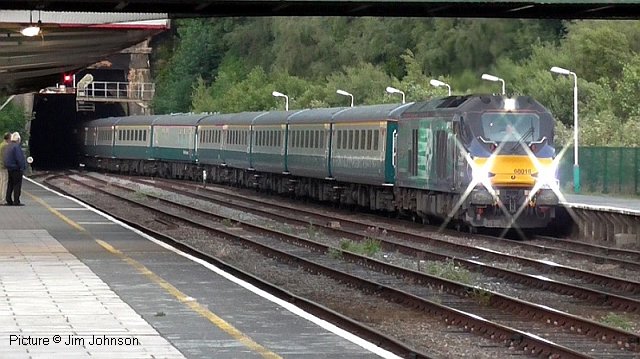
... and Bangor (Jim Johnson). The train continued empty at 21:44 as 5Z51 to Holyhead for servicing. The coaching stock was the rake used earlier that day on the 'Nosey Peaker' charity railtour.
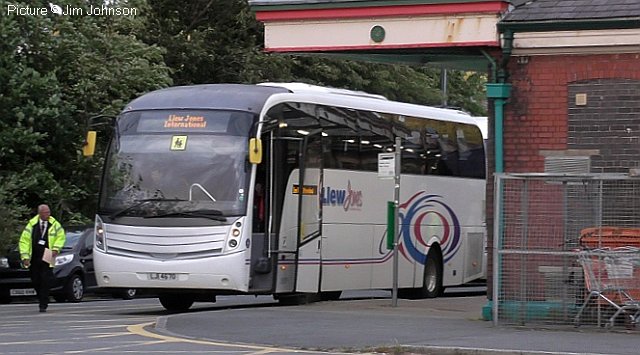
The participants travelled by coach, including this Llew Jones vehicle, LJI 4670, a Scania K340EB4 / Caetano Levante built in 2007, to the start of a Snowdon path, then ran to the Summit and back before re-joining the train at 04:40 to Ravenglass, Cumbria (arr. 08:6) for a trip on the Ravenglass and Eskdale Railway and a climb of Scafell Pike.
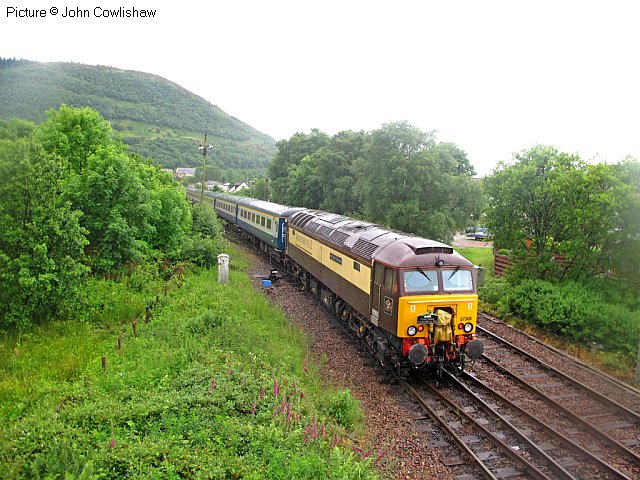
Joining the train (which had returned to Barrow for servicing) again in the evening, there was an overnight journey via the Cumbrian Coast to Carlisle and on to Fort William (04:29), where a climb of Ben Nevis was the final challenge before the departure of the train at 12:30 to Crewe. Our contributor John Cowlishaw, on holiday in Fort William, captured the train making its way from Fort William yard to the station, revealing 57 305 Northern Princess on the rear.
New franchise details explored - by Geraint Rowlands
Following the announcement of details of the new Wales and Borders Franchise two weeks ago, I was one of many who were poring over the details, reading the tea leaves, and discussing our findings on the UK Rail forums (railforums.co.uk). Iíve written a summary of our conclusions relating to North Wales:
Five Vivarail Class 230 diesel/battery units are due to arrive in early 2019, intended for the Wrexham-Bidston service. When the frequency is increased to two trains per hour (tph) in December 2021, four daily diagrams will be needed (with the fifth unit as a spare), but only two are needed until then. Using the other units on the Conwy Valley and Chester - Crewe diagrams will allow class 150 units to be sent to South Wales, helping to release other units that need to be sent for PRM (persons of reduced mobility) accessibility modifications, and also displace Pacers which arenít due to be kept after 2019.
The current hourly service has barely any turnaround time: 3 minutes at each end according to the working timetable; in the public timetable trains leave Wrexham Central two minutes before they arrive! To keep time and give more resilience to the half-hourly service, 1 train per hour (tph) each way will run limited stop, presumably skipping some of the smaller stations. 2 tph at Shotton will make connections with the North Wales Coast more practical. The 60mph top speed of the Class 230 makes it an odd choice for the Chester-Crewe shuttle, which is a 20-minute non-stop run with line speeds mostly 90mph. Having said that, the class 150 units that often operate the service these days have a top speed of 75mph.

[This picture of 230 001 on a test at Tyseley on 29 November 2016, and the one below, are by Chris Morrison.]
The Daily Post reported that the Welsh Government are in advanced talks about extending the Bidston service to Liverpool. The Class 230 units could run under the Mersey to Liverpool James St, but not around the loop line to Lime Street, because they will have no front door for emergency evacuation in the single-track tunnel. There would also be a need for extra units to extend the service. The likely intention is, once the 2 tph service has shown increased passenger demand, for a follow-on order of the Class 777 units ordered by Merseyrail (possibly in a bi-mode configuration). Who runs the extended service is another matter, presumably part of the Ďadvancedí negotiations.
In other news, the service to Liverpool Lime Street over the Halton Curve is due to run hourly as far as Chester from December 2018, and will be extended to both Llandudno and Shrewsbury from December 2022. (The Shrewsbury service will continue to Cardiff in alternate hours.) Chester will see the same type of coupling procedures currently seen at Machynlleth and Shrewsbury with the Class 158s: by 2022 the 175s will be withdrawn, so this extended Lime Street service will be operated by the new trains (with end corridor connections). There will be 'direct services between Manchester Airport and Bangor' from December 2022 as well. Given that Llandudno is to receive services from Lime Street, it appears that all Manchester Piccadilly/Airport services will be diverted to run to Bangor instead. Good news for the students at the university!
The Holyhead - Cardiff services continue to run every two hours, but the current express service will be integrated into that two-hourly timetable instead of being a stand-alone service. There will be three loco-hauled services in each direction each day, presumably morning, lunchtime and evening, and hopefully with the same standard of catering and accommodation that is currently provided. The current Mark III carriages will be replaced by twelve Mark IV carriages displaced from the East Coast Main Line. Operating the announced frequency will require two rakes in service (and one spare), suggesting that the trains will be four coaches long. Thereís no word on what traction will be hauling these rakes, but one can presume that theyíll continue using a Driving Van Trailer at one end.
The replacement of all the 158s and 175s with new rolling stock during 2022 will make diagramming easier for the planners, with one ERTMS-enabled homogenous fleet. The units will be no longer than the 175s, being a mixture of 2 and 3-car units, but with end corridor gangways coupling units up for strengthening will be straightforward, and there will be no disruption to the current policy of running through services from Birmingham/Shrewsbury to both Aberystwyth and Pwllheli. When the new rolling stock arrives, as well as having enough units to run a full hourly service between Shrewsbury and Aberystwyth, thereíll be some available to run extra services on the Cambrian Coast on summer Sundays from 2023, with talk of some limited-stop extras by 2025 between Tywyn and Pwllheli. A promise of keeping jobs in Machynlleth suggests that some of the new fleet will be maintained there; there is no equivalent statement for Chester, however.
There is no mention made of the current Holyhead to Birmingham (via Shrewsbury) service in any of the literature released. Is this because there are no changes to be announced, or because itís being dropped? The current hourly Holyhead - Shrewsbury - Birmingham/Cardiff, combined with Liverpool - Shrewsbury/Cardiff from 2022 would result in 2tph between Chester and Shrewsbury. The capacity to do this was the original goal of Network Railís redoubling of the single-track line between Chester and Wrexham, but this was delayed by several years, and the redoubling was reduced in scope somewhat.
Thereís no longer any spare capacity at Stafford to divert the Holyhead - Birmingham service to its old route via Crewe, but, if the Holyhead-Birmingham service were to be dropped then there would only be one service every two hours across Anglesey, with request stops served by the loco-hauled express services. At the other end, whereas an hourly service on the Cambrian extends from Shrewsbury to Birmingham, the announced train service improvements only state 1tph between Aberystwyth and Shrewsbury. On balance it looks like the current Holyhead - Birmingham stays.
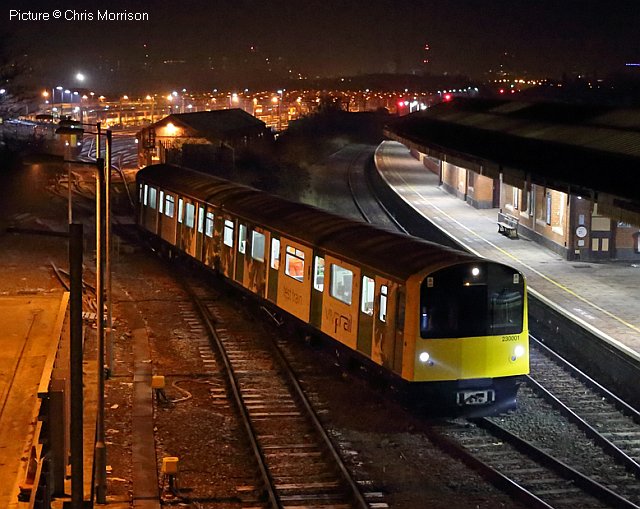
No mention is made of the Crewe - Shrewsbury stopping service, nor of the Conwy Valley, other than the use of Class 230 units on the latter. What stock will be running to Blaenau Ffestiniog when all the 230s are needed on the Borderlands line, and virtually every service on the North Wales Coast is operated by the new-build DMUs? Operational convenience suggests it will be the same stock as the mainline.
Once all the above improvements are implemented, there will be increased service frequencies for much of North Wales. Wrexham to Bidston will be 2 tph, Chester to Llandudno Junction will be 3 tph, Junction to Bangor 2tph, and Bangor to Holyhead 1 tph (excluding Virgin West Coast services to London). The Llandudno terminators currently shuttle to the Junction and back during their forty-minute layover before returning to Manchester to give 2tph on the branch, are likely to continue doing so when they operate to Liverpool instead. One could remove the long layover at Llandudno and save a unit by running non-stop between Chester and the Junction, but that would leave no direct service to Llandudno from any station along the coast. I therefore expect the Llandudno service to remain the stopping service along the coast. West of the Junction, it is possible that Penmaenmawr, Llanfairfechan and Conwy stops will be transferred to the Manchester Ė Bangor service, leaving only the Anglesey request stops in the hands of the Holyhead stoppers.
There may be changes to stations served east of the Junction, but Iíve now run out of tea leaves in my cup, so we'll have to wait and see.
Halton Curve (late) news
Reporting in our last issue the Liverpool - Cosford 'Northern Belle' excursion on 10 June, we failed to appreciate that that it was the first passenger train to traverse the Runcorn - Frodsham 'Halton Curve' in the Frodsham direction, since the movement was made possible by recent changes to track-work at each end. Regular services commence in December 2018, as mentioned above. The line itself remains single-track.
Kinmel Relics
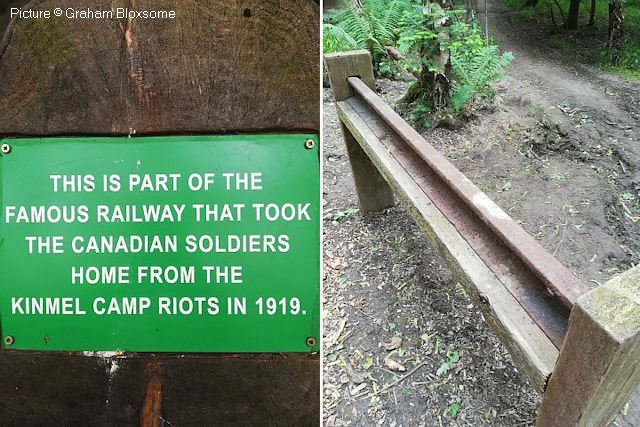
Graham Bloxsome writes: 'Whilst taking the grand-kids around AdventureTrail, which lies within Kinmel Park on 17 June, we came across this interesting piece of history. This area formed part of the Kinmel Army Camp.'
Our 29 June 2016 issue includes an item about this railway, and an article on the BBC website has details of the riots, which came about when Canadian soldiers housed there in poor conditions found that their re-patriation was being delayed in favour of others. Almost 15,000 soldiers were housed in the camp.
From the page referenced above we read that 'They were sleeping 42 to a hut in accommodation that had been designed for no more than 30. Men were taking it in turns to sleep on the floor and most of them had only one blanket to keep them from the cold of a north Wales winter. Several delegations were sent to the senior officers in the camp, protesting about conditions and the way the men felt they were being treated. Nothing was done.'
The narrow gauge Snowdonian - report by Jim Ikin
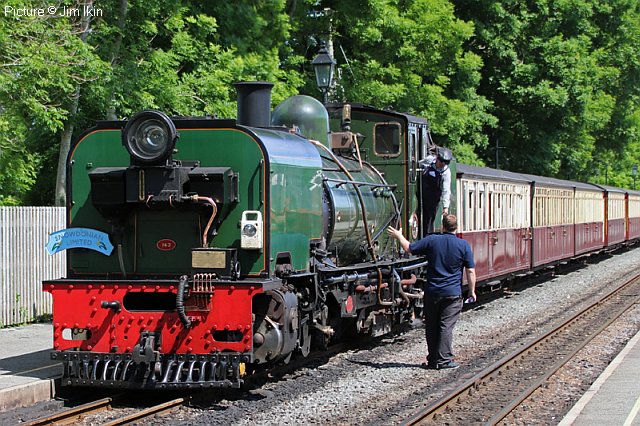
The annual 'Snowdonian' through train from Blaenau Ffestiniog to Caernarfon and back took place on Saturday 9 June. I met it at Dinas (above), where the participants had a lovely-smelling lunch - on its return from Caernarfon with Garratt 143 at its head.
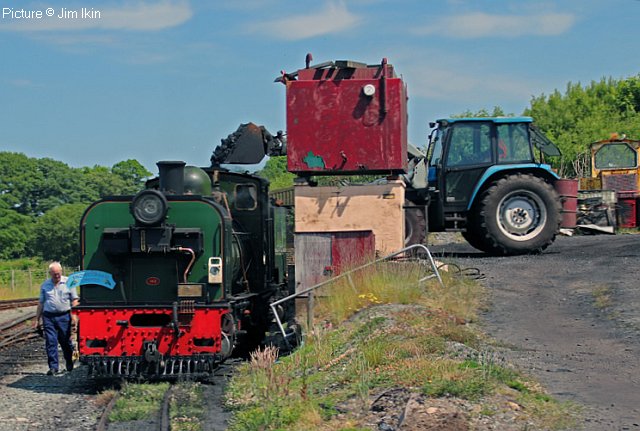
Refuelling.
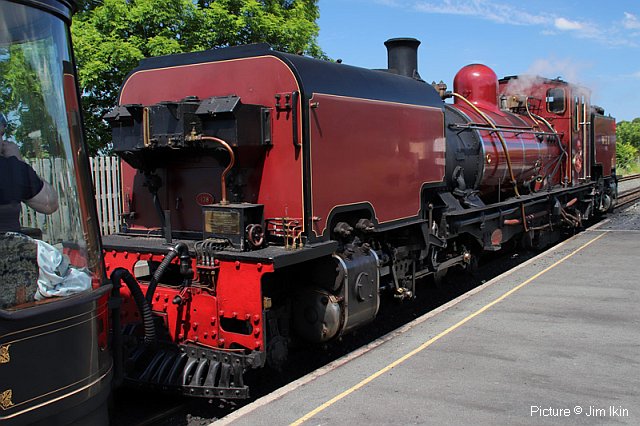
A crossover with a Caernarfon train hauled by 138 ...
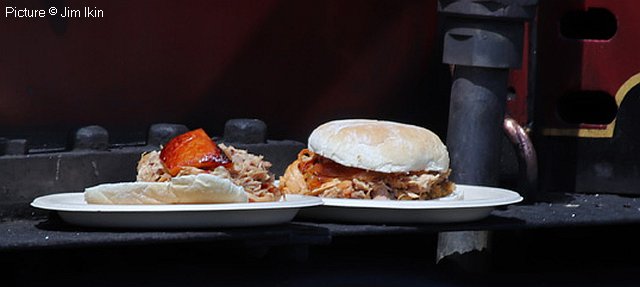
... whose crew enjoyed their lunch ...
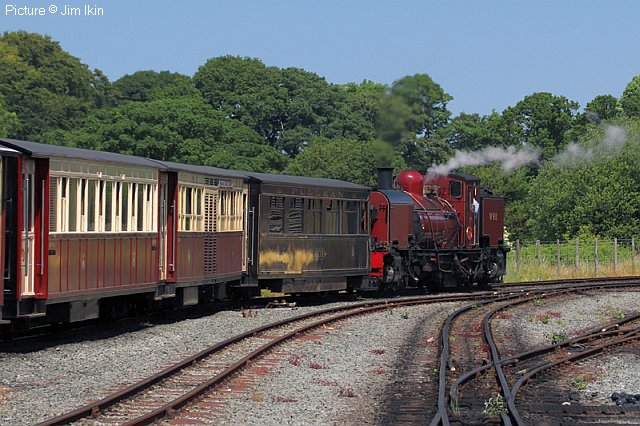
... before leaving for Caernarfon.
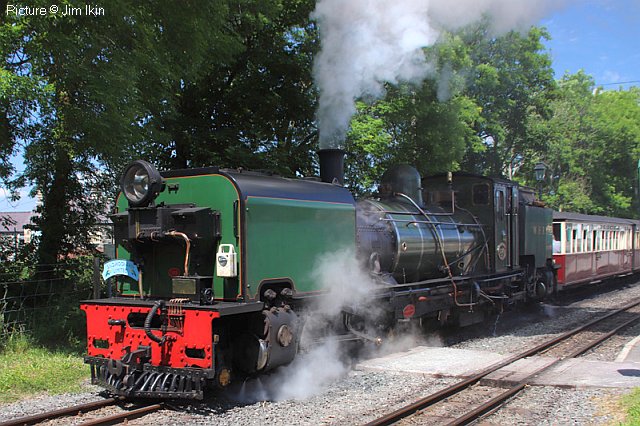
The special leaving Dinas for Porthmadog.
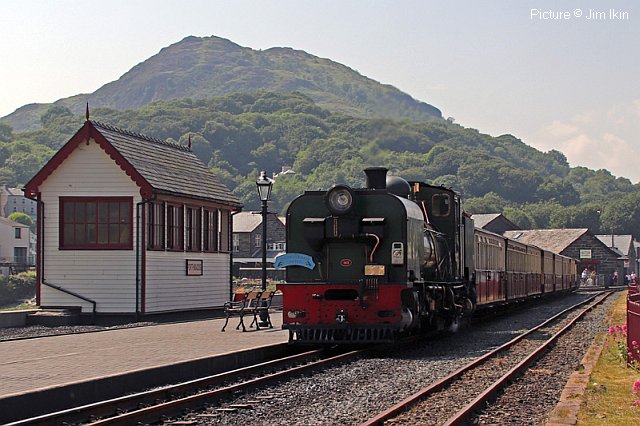
Passing through Porthmadog station to change engines at Boston Lodge.
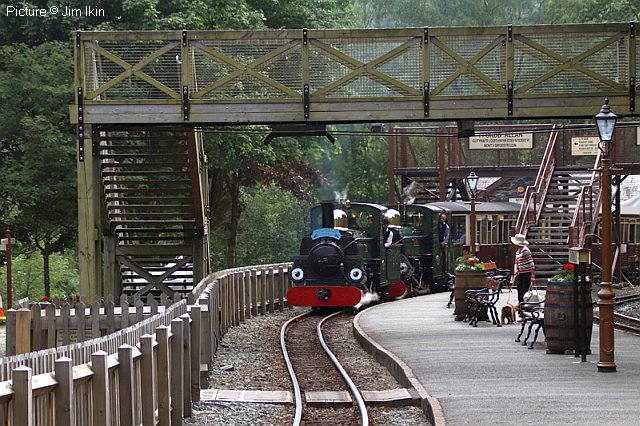
Now with Linda and Blanche in charge, the train arrives at Tan-y-Bwlch for an half hour break for tea ...
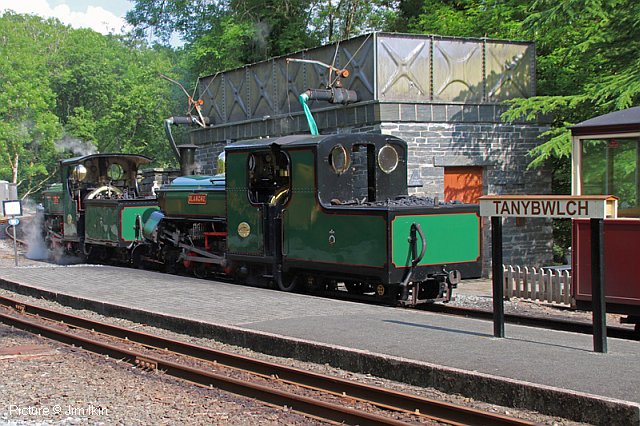
... while the engines receive water ...
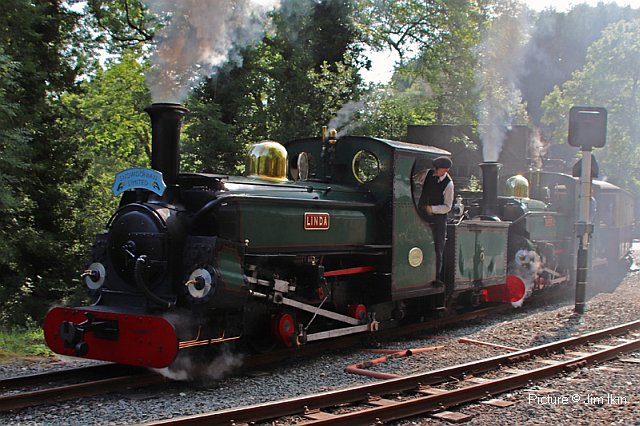
... and then depart for Blaenau Ffestiniog.
Corwen gains a water tank - report by George Jones

The delivery of a new-build water tank to the Corwen site on Tuesday 12 June brought one phase of the civil engineering project to completion. Built by local engineering firm Barnett Engineering at Rhosllanerchrugog, the traditional heritage style tank is built to modern standards to meet current regulatory requirements.
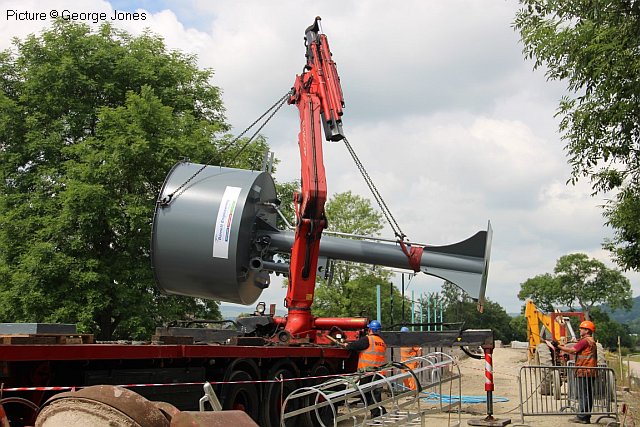
Weighing in at 5 tonnes and standing 7 metres high, the low loader delivery demonstrated the impressive versatility of the on-board Hiab crane to offload the assembly, bring it to a vertical and place it on the prepared concrete plinth, all in the matter of a two-hour well-co-ordinated exercise.
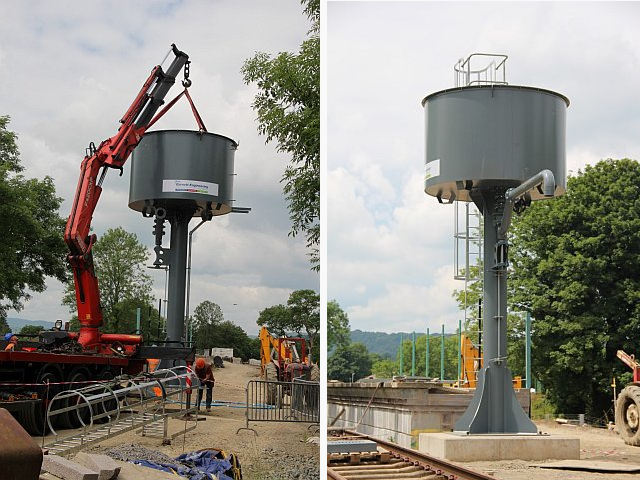
The tank is now linked into the water supply from the adjacent borehole and awaits a trial filling of the 2,000 gallon tank. The project was possible by the support given the Corwen Water Tank project by those who contributed to the appeal fund. This has raised £17k in donations and fundraising activities, as a substantial contribution to the overall cost of the work to provide a locomotive water supply to the new terminus. it now stands as a major item of railway infrastructure at Corwen and a statement that Llangollen Railway intends to complete the terminus station given adequate resources. Work on the station site now proceeds with the building of the platform 1 wall and subsequent infill to create the island platform which will be the main task for this summer.
Details of the Llangollen Railway's Classic Transport Weekend on 30 June / 1 July are now available online.
Bala Lake's Penrhyn Gala - report by Martin Evans
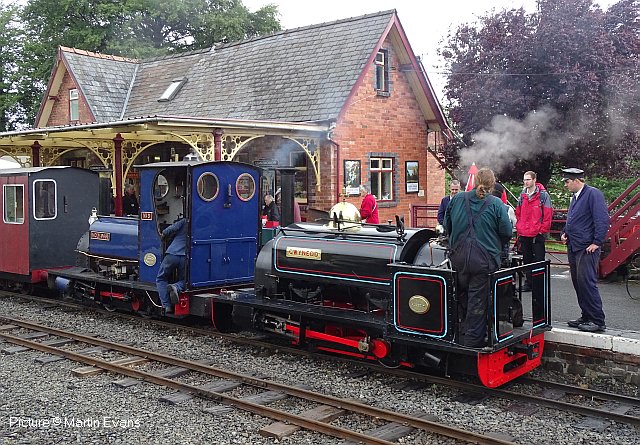
On 16 June I visited the first day of the Three-day Penrhyn Quarry Steam Gala at the Bala Lake Railway and found the following 3 visiting engines in traffic: Hunslet Gwynedd Works No. 316 built in 1883 and a sister locomotive to our resident "Winifred" visiting from Bressingham Steam Museum & Gardens. Above, Gwynedd and Hunslet Holy War wait to depart Llanuwchllyn with the 1.30 pm service to Bala.
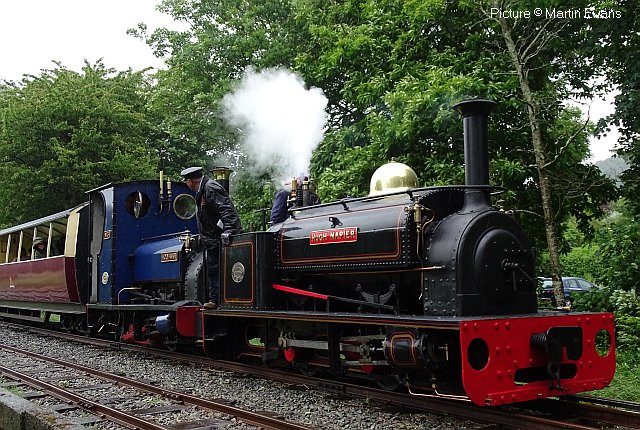
Hunslet Hugh Napier, Works No. 855 built in 1904 is owned by the National Trust, and was visiting from the Ffestiniog Railway. It is seen with Holy War at Llangower waiting to proceed into the platform with the 11:40 am service from Bala.

Avonside Marchlyn Works No. 2067 built in 1933 visiting from the Statfold Barn Railway waits its next turn of duty at Llanuwchllyn.
Resident locos at the Railway were in steam as follows-
Alice, Hunslet works no. 780. Built in 1902, Alice is the sister engine to Holy War (No. 779). She worked at Dinorwic until about 1960. She was then used for spare parts at the quarry and purchased as a source of spare parts by the then owner of Holy War. In 1977 the remaining parts were gathered together at the Bala Lake Railway and in 1987 these remains were purchased by BLR volunteer worker Chris Scott & work started on restoration. The remains were later moved to the owner's garage, the Ffestiniog Railway and onto the Leighton Buzzard Railway who agreed to finance the new boiler. Alice returned to steam in 1994, having been rebuilt in the style of quarry locomotives - cabless and with dumb buffers made from large lumps of timber. The locomotive moved back to the Bala Lake Railway in 2003. She was purchased in 2010 by Julian Birley.
George B, Hunslet works no. 680. Built in 1898 and originally named Wellington, the engine was purchased from Dinorwic in 1965 by Alan White who moved the loco to Ashchurch, Gloucestershire home of the Dowty Railway Preservation Society. The engine ran for a couple of years on the Dowty line but was withdrawn from service in 1969 and stripped down to enable a total overhaul to be carried out. Due to changing circumstances, while much work has been done on components, the loco was not reconstructed. Following an agreement between Alan White and Bala Lake Railway, all the parts were moved to Llanuwchllyn to enable a full rebuild to take place. Restoration to full working order was completed in the Spring of 2017 and George B is now part of our operational fleet.
Holy War, Hunslet works no. 779. Supplied new to the Dinorwic Slate Quarry in 1902, Holy War worked up to 1,860 feet above sea level. She was the last steam locomotive to work in a British slate quarry finishing at Dinorwic in November 1967, ending 120 years of steam in the quarries.
After leaving Dinorwic she was taken to Quainton Road, near Aylesbury, for preservation. In 1975, Holy War was purchased by Rev. Alan Cliff, then Minister of Wrexham Methodist Church and arrived at Llanuwchllyn that December. Following overhaul she entered passenger service in 1979 and has worked regularly ever since, except for extensive boiler repairs 1985-1987. Holy War was purchased from Alan Cliff by the railway company in 1989, securing her long term future at Llanuwchllyn.
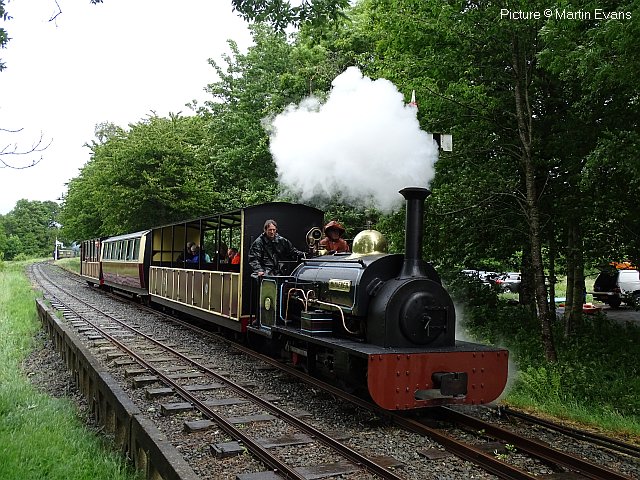
Winifred, Hunslet works no. 364 Winifred was built in 1885 by the Hunslet Engine Company for the Penrhyn Slate Quarry. She spent most of her working life at Port Penrhyn where she sorted wagons of slate ready for loading onto ships for transport all over the world. She then spent the last ten years of her life working in the quarry itself. When the quarry decided to change to diesel locomotives she was sold and transported to America where she spent the next 50 years in a museum store out of sight. She was purchased by Julian Birley in 2012 and brought home to Wales. Following completion of an extensive overhaul in our own workshops Winifred returned to steam in the spring of 2015.
North Wales Coast home page | Archive | Previous Notice Board